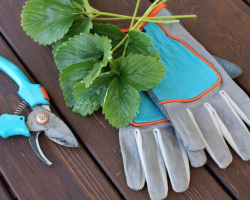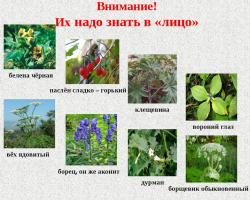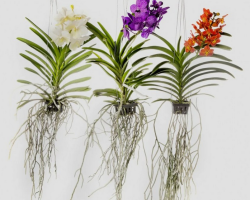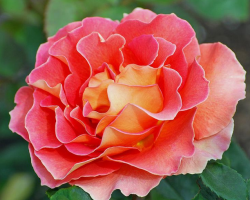Pierris Japanese plant is a beautiful shrub. Read the article on how to care for it and how it multiplies.
Content
- What the Pieris plant looks like: a description of the shrub, photo
- Types and popular varieties of the Japanese pieris shrub: Prelude, Flaming Silver, Variegat, Little Hif, Mountain, Debutant and others
- Reproduction of the pieris shrub: from seeds, cuttings, layering and root shoots
- Piercing Pieris in open ground in the garden: the requirements for choosing a place and composition of the soil, how to plant it correctly?
- Pieris care: watering and top dressing
- Phyris plant: Do you need pruning?
- Pierris Japanese: winter hardiness
- Diseases and pests Pieris
- Pierris in landscape design
- Pierris Japanese: Reviews about growing
- Video: Pierris Japanese Little Hef Green. Brief review, description
- Video: The most unpretentious flowering shrubs for the garden and in the country
Pierris Japanese - A decorative plant, which is an evergreen shrub, characterized by slow growth. Alternative, better known to gardeners, the name is a trunk.
Read on our website an article on the topic: "Why is plants not recommended watering with cold water?". You will find out what plant crops can be watered with cold water.
Culture can decorate any area, since it is unusual, but at the same time very attractive flowering. However, Pieris, like any plant in the garden, needs attention. Provide him proper care - and he will delight you with his charming look. More information about growing, reproduction and care is described in this article. Read further.
What the Pieris plant looks like: a description of the shrub, photo
It is difficult to confuse Pierris, which has elegant pink-red shoots with oval leaves with other decorative plants. What does the Pieris plant look like? Here is a photo:

- This culture has rather thick brushes, forming bell -shaped flowers.
- And although outwardly the flooded is slightly similar to the lily of the lily of the forest, in fact, it may seem only at first glance.
History of the plant:
- Pieris - This name has a very interesting and long history.
- Its roots go back in ancient Greek times, and it is connected with pierides - the daughters of the thunder Zeus.
- They lived in one of the parts of Macedonia, and scooped their inspiration from mythical Pierce source.
- Because the Pierides They patronized science and various types of art, the mentioned flower is also a symbol of these industries.
- Apparently, therefore, it is recommended to keep it in the house for people who are engaged in music, painting, literature.

Read on our website another article on the topic: "The most interesting plants in the world are strange, poisonous, beautiful, rare, dangerous.". You will find a description in it, photo.
Shruck description:
- In appearance, the shrub is quite compact and neat.
- He can grow in height from 0.5 to 6 meters.
- Since Pieris refers to heather cultures, he is able to create symbiosis with mushrooms. Therefore, for their cultivation, acidic soil is extremely necessary.
- The leaf plates in the plant can have an oval shape, and are elongated. At the ends they are pointed, and at the edges they have numerous small cloves.
- The leaves on the shoots are localized in a spiral order, but there can also create bundles on the surface of the rays.
- The growths at the very beginning of their formation are painted in pink, raspberry or completely white, but gradually they become green.
- Bell -shaped floral corolla has a size from 0.5 to 1.5 cm. Their color can vary from whitish to pink or raspberry red (red-pink). Together, these elements form panicous inflorescences, reaching in length up to 12 cm and having an erect or drooping position.
In the active phase of growth and flowering, culture gives fruits. They look like wooden capsules with 5 sashes. In the shape of the berry flattened on both sides.
Important: With Pieris it is necessary to be careful. When any part of the plant enters the human body, arterial hypotension, diarrhea, inhibition of breathing, vomiting and dizziness occur. All these symptoms are associated with the presence in the culture of the toxic substance (glycoside) of Andromedotoxin.
Types and popular varieties of the Japanese pieris shrub: Prelude, Flaming Silver, Variegat, Little Hif, Mountain, Debutant and others
Pierris Japanese - This is a shrub that has a variety classification. The features of its flowering, height, color and other parameters depend on the variety of culture. The most popular among gardeners are the following varieties and types of decorative flower:

- Flamingo. For this flower, characteristic features are a small height (not more than 120 cm) and dark pink flowers.

- Little Hif. A shrub that belongs to a group of dense low -growing crops.
- The shoots are initially painted in a pinkish color, but over time it becomes green, at the edges - whitish.
- It is distinguished by good adaptive properties when being in the shade and in the sun, but it is afraid of the wind.

- Mountain Fire. Mountain - This bush is quite small and compact, but dense.
- Its maximum height is 120-150 cm.
- The leaves on the shoots are painted in a red or red-brown tint.

- Prelude. Grows up to 1 m in height, has white flowers growing in large quantities, and green, saturated in color of foliage.

- Variegate. The shrub can grow up to 2 m up.
- In young shoots, the color is pinkish, but over time it becomes green.
- The leaves have a rich green tint and are characterized by glossy shine.
- There is a silver border on the sides.
- Inflorescences tend to gather in bundles, forming panicles.

- Debutant. A variety of stunted pieris garden.
- Its height reaches no more than 1 meter.
- He has no special distinguishing characteristics.

- Flaming Silver. Flaming Silver, or Silver Pierce is very popular among gardeners. And all thanks to the beautiful white border along the edges of the leaves.
- White buds consist of bells and have a very pleasant aroma.
- The shrub prefers peat soils and shady areas.

There are still many varieties of Pieris that can be grown in the garden. For example, a very beautiful representative of these decorative plants is Red Mill. This bush is also very miniature and compact, having a rather thick crown. He can grow in height up to 1.5 meters, but it only reaches such sizes over 10 years vegetations. The plant justifies its name, since the color of the sheets is unusual, bright red. The flowering period in this variety falls on April.
Reproduction of the pieris shrub: from seeds, cuttings, layering and root shoots

The plant does not cause special difficulties in propagation. This process can be performed in several ways, each of which has its own characteristics. Here are the types of reproduction of the pieris shrub:
Growing from seeds:
- To begin with, it is worth purchasing planting material of the desired variety.
- After acquiring the grain, inspect and sort it out so that there is no insufficient raw materials among them.
- When the preparatory procedures are completed, you can sow grains into the ground, which consists of peat, coniferous soil and coarse sand (it can be found on the river).
- It is recommended to sow planting material in March. Lay the grains on the surface of the earth and slightly sprinkle with soil mixture.
- A film is placed on top of the container, after which the containers themselves for growing seedlings are placed in good lighting conditions.
- For full growth in seedlings, room temperature is quite suitable.
Reproduction with cuttings:
- The propagation of Pieris is carried out by cuttings, as a rule, in August.
- But in order for the culture to take root well, it is recommended to cut the pagons when they reached the length 10 centimeters.
- Treat the cut place with phytohormones, and then place in pots filled with specially prepared soil mixture.
- Planting material needs moderate moisture, while covering the container in which the stalk is located is not necessary.
- Cuttings take root quite quickly and do not require additional care.
Propagation of Pieris with layering and root shoots.These methods of Pieris propagation are realized in the following ways:
Using layering:
- You need to choose a pagon for further use as planting material in the lower part of the crown.
- It is recommended to do the procedure at the very beginning of summer.
- The escape should bend to the ground and fixed with a bracket so that it does not return to its original position.
- Sprinkle it with soil in such a way that the top remains above the surface of the soil coma.
- Layering form the root system during 1-2 growing season, after which they can be separated from the maternal shrub and transplanted to a pre -selected place in the garden.
Propagation root.
- It is dug up in the spring, until the active vegetation period of the plant.
- Although such a manipulation can also be performed during the early autumn season - then the shrub will have time to take root before the next growing season.
You can choose any of the propagation of Pieris-each of them is good in its own way, in addition, none of them requires too much effort.
Piercing Pieris in open ground in the garden: the requirements for choosing a place and composition of the soil, how to plant it correctly?

For culture, it is necessary to prepare in advance the bed in the garden or a whole flowerbed. Remember that on any soil Pieris will not grow - the soil should be quite sour. But in lime land the plant will die very quickly. In general, seedlings of seedlings are carried out in several stages. How is Pieris's landing in open ground? How to plant correctly? Here are the requirements for choosing a place and composition of the soil:
Choosing a place:
- It is necessary to choose a place in the garden especially carefully.
- An ideal option will be a plot that in the early morning a shadow falls from the highest structure or wood nearby.
- Variegate varieties of Pierris require good lighting, otherwise their leaves will fade, lose their variegation and become just green, or even matte.
Important: You must not allow the plant to be planted in a windy place. Pierris does not stand drafts, under their influence he may not die, then lose most of his decorative properties.
Soil features:
- For planting Pieris, a sour, loose soil containing peat is perfect.
- The soil should pass moisture and air well.
- Do not plant the plant on raised mounds, since it has a surface root system, which in this case may be bare. Therefore, the bed should be completely flat.
How to plant Pierris in open soil? Here are a few nuances:
- Pits for shrubs should not be too deep - it will be enough to make holes 15-20 cm. At the same time, it is recommended to expand them around the perimeter in such a way that their parameters make up 1x1 m.
- Fill the prepared recesses in advance by the soil mixture.
- Before planting bushes, it is recommended to measure the acidity of the soil. For the plant to take root, the pH of the Earth should be at the level 3.5-5.0 units.
- You can additionally add a little sulfur and mineral fertilizer to each hole.
The root neck of the seedling should be located at the ground level. After all the holes are filled, the planting material is sprinkled with earth and is lightly compacted. At the very end, pour the plant and conduct mulching with peat or wood sawdust. During the first weeks after landing, young cultures will need abundant watering.
Pieris care: watering and top dressing

Pierris loves moisture very much. Moreover, this applies not only to young specimens, but also by mature shrubs. Pieris care - Watering:
- It is important to water the culture twice or three times a week - depending on the weather.
- For each near -barrel space you will need 10 liters of water.
- Shrubs over the age of two years are watered every other day, but the volume of fluid is taken twice or three times less.
- In hot weather, Pieris needs not only moisture, but also spraying.
- Before using water for any purpose, you must pre -measure its level pH. For the culture under consideration, only a liquid is suitable, the acidity of which is 4-5 units.
As for top dressing, they are introduced every 2 weeks. However, it is allowed to use only those fertilizers that do not contain alkalis. Specialists advise a person to give preference to organics - bird droppings or mullein:
- Top dressing is diluted with water in the ratio 1:30 or 1:10 respectively.
But it is worth considering that when planting young bushes, it is not recommended to make fertilizers.
Phyris plant: Do you need pruning?
Periodically, the Pieris plant must be cut. This should be done with special accuracy using special garden scissors, a sharp knife or sharpened petters. Only dry and faded branches are removed.
Pruning is recommended to be done at the end of the growing season or as the “aging” of individual parts of the bush. After removing individual elements, the site of the sections should be treated with antiseptic or fungicidal solution.
Pierris Japanese: winter hardiness
In the cold season, the shrub cannot be left on the street. This is especially true for young specimens who are very afraid of severe frosts. The plant is not good winter hardiness. At air temperatures below -20 ° C. Culture may die.
However, this does not apply to adult bushes Pieris Japanese. They take even the most severe frosts very well and steadfastly. It is enough for the winter to place the spruce branches on the roots of the plants, and the bush itself is covered with plastic film.
Diseases and pests Pieris

The Pierris plant has high resistance to phytopathology. Culture is distinguished by strong immunity, in addition, all its parts contain the toxic substance, which was mentioned earlier. However, it is also impossible to completely exclude the risk of diseases and the appearance of pests. The most common of them:
Fungal diseases:
- They are found in Pieris in an overwhelming number of cases.
- The fight against such phytopathologies involves the use of special fungicidal preparations.
- You can purchase them in a store with goods for gardening and gardening.
Chlorosis:
- You can recognize it by yellowing or pale of Pieris leaves.
- Phytopathology develops due to a violation of the secretion of chlorophyll in the leaves of decorative culture.
- As a result, photosynthesis processes slow down, which can cause the death of Pieris.
- Since one of the main causes of chlorosis is the lack of iron, drugs based on it are the first -line products in the fight against phytopathology.
Spider mite:
- This is the most frequent parasitic disease.
- It can be recognized by the appearance on the surface of the leaves and stems of the culture of special web.
- They have a whitish color, and when touching it, you can feel stickiness.
- This phytopathology can only be used if the phytopreparations are used from the insecticide group.
Sometimes pieris is detected by late blight. However, such cases are quite rare in garden crops, and indoor are completely exceptional.
Pierris in landscape design

Pierris will be a great option for decorating a gorgeous landscape design in a summer cottage. In addition, culture goes well with many other colors in the garden. Thanks to this, you can create unique compositions that will delight the eye, and attract attention.
Azalea and hydrangea, as well as heather and trillium, will be excellent "neighbors" for the trunk. But you can use shrub for single plantings. In landscape design, it is used to decorate flower beds. And not only at home, but also in the design of areas, squares and other flower corners in public places. Pierris is suitable for decorating curbs, alpine slides, walking paths, Japanese gardens.
Pierris Japanese: Reviews about growing
Pierris Japanese is a very popular decorative plant among gardeners. It does not require special care and is not too whimsical to surrounding conditions. Therefore, it is not surprising that reviews about growing culture are predominantly positive.
Larisa, 46 years old:
“Pieris gave me a friend, she has her own store of decorative plants. I am not very inclined to breed such exotic plants, for some reason they always seemed too whimsical to me. However, in the case of Pieris, I was pleasantly surprised. He takes root very well and quickly, although he had to prepare a separate soil mixture for him. True, during the first two years it was necessary to wrap the bushes well, but since our winters are not too harsh, the plant perfectly suffered cold. Pierris blooms very beautifully, it has become a real decoration of our summer cottage. ”
Valentina, 23 years old:
“We bought Pieris seedlings in the market purely by accident. I was looking for something unusual for my garden, and the seller offered me this particular plant. By the way, I landed it not only in open ground - it also grows in a room pot and decorates our living room. A very beautiful, cute flower, and goes well with other plants in the garden. ”
Vera, 38 years:
“PierisRed Mill- A unique flower. I have not seen such a beautiful and lush flowering yet. And from the unusual color of the leaves it is simply impossible to look away! Many neighbors have already asked me to give them grain or, at least, the cuttings of the flower. Everyone wants to see the same beauty in their garden. Yes, he has to tinker with him, he is slightly moody in terms of care. It is especially important to correctly create soil mixture for the flower, and it also loves moderate irrigation. Although, many other decorative plants also require attention, so I will not say that it is too difficult to take care of Pieris. ”
Pieris is a plant that cannot be attributed to ordinary decorative cultures. At any time of the year, he looks very presentable and solid. If at first young bushes will have to be hidden for the winter, then over time they will get stronger, and with not too harsh winters they can be admired all year round.
Video: Pierris Japanese Little Hef Green. Brief review, description
Video: The most unpretentious flowering shrubs for the garden and in the country
Read on the topic:
- Jasmine - shrub and indoor plant Stefanotis
- TOP-5 plants for vertical landscaping on the site, design ideas
- Mother-in-Ma-Machekh therapeutic plant: description, story for children, preschoolers
- Trees, shrubs, grassy plants: examples, differences
- Rosemary plant - growing in open ground: landing, care, pruning







